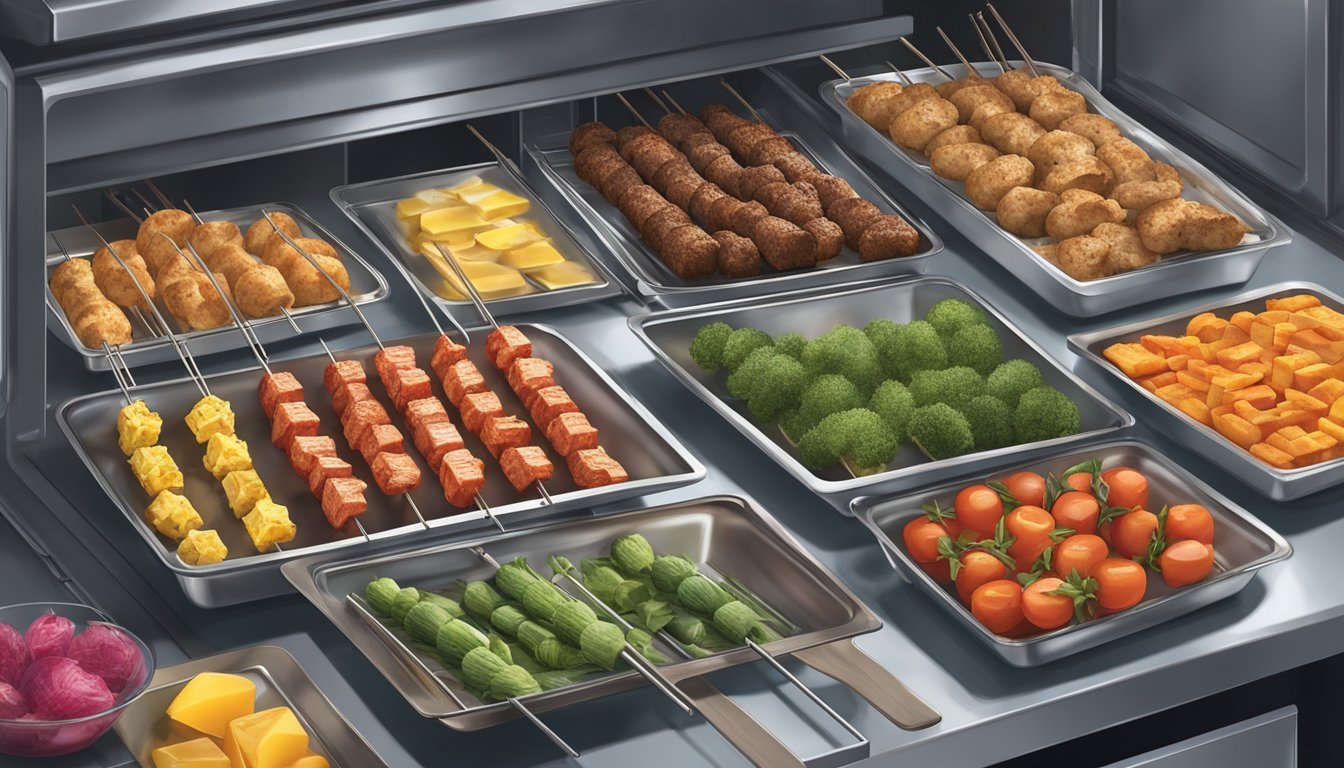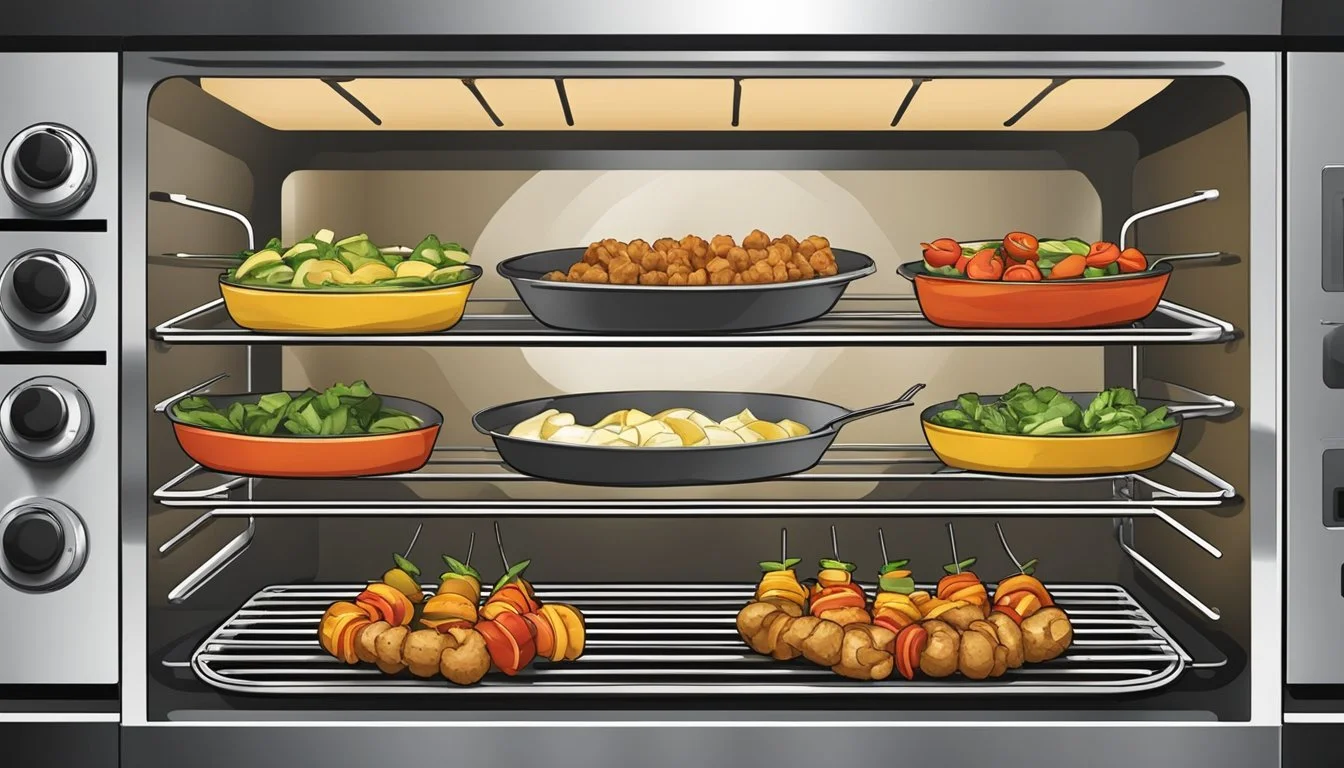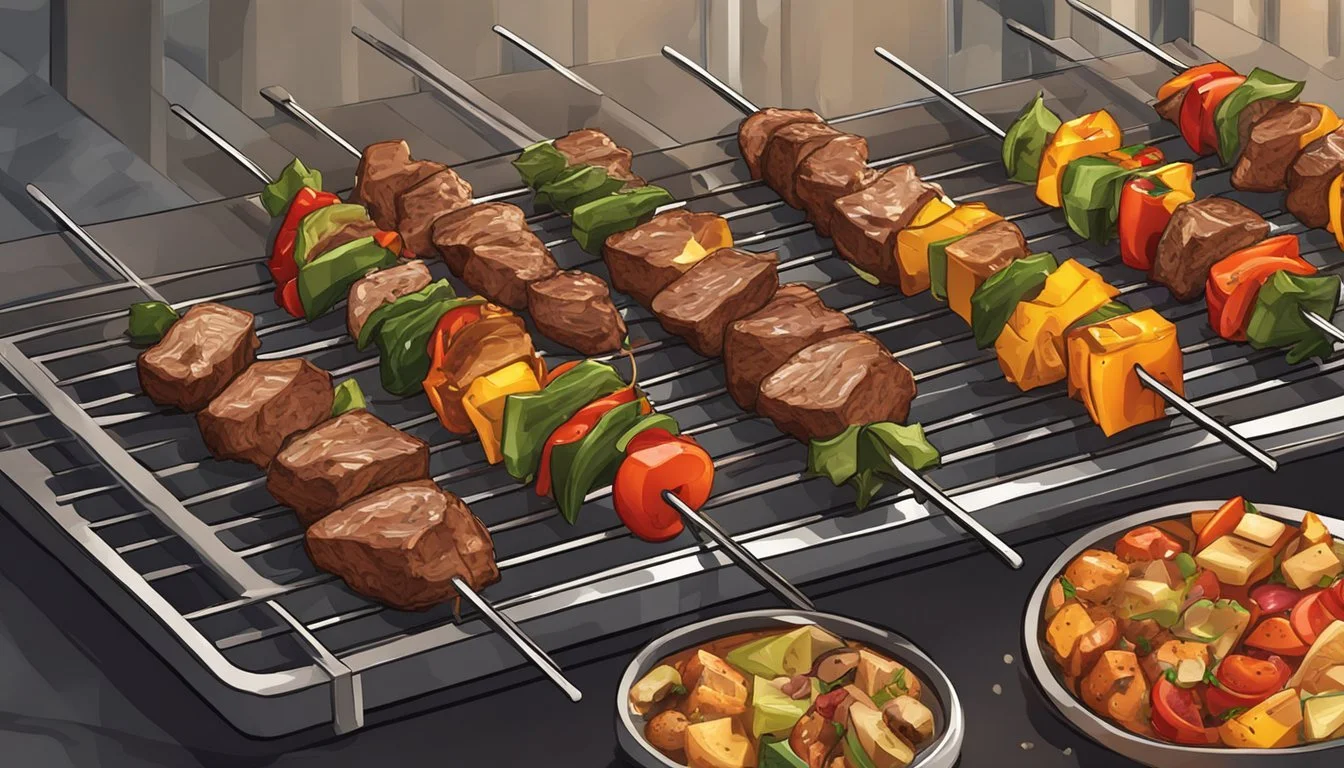Oven-Baked Kabobs
Juicy and Flavorful Skewers Without the Grill
Cooking kabobs in the oven offers a convenient and delicious alternative to grilling, especially when outdoor cooking isn't an option. This method allows for easy preparation and consistent results, making it perfect for both novice and experienced cooks alike. Baking kabobs in a preheated 375°F oven for about 15-20 minutes, flipping halfway through, yields juicy and flavorful results.
Oven-baked kabobs provide versatility in ingredient choices, from classic beef and chicken to vegetarian options. The key to success lies in proper preparation, including marinating the meat for enhanced flavor and tenderness. Using metal skewers or soaked wooden ones prevents burning, while arranging the kabobs on a lined baking sheet ensures easy cleanup.
For an extra touch of color and crispiness, broiling the kabobs for a few minutes at the end of cooking can mimic the charred edges typically achieved on a grill. After removing from the oven, letting the kabobs rest under foil for a few minutes allows the juices to redistribute, resulting in perfectly cooked and mouthwatering skewers ready to be served.
The Basics of Oven Kabob Cooking
Cooking kabobs in the oven offers a convenient and delicious alternative to grilling. This method allows for precise temperature control and even cooking, resulting in tender, flavorful meat and perfectly roasted vegetables.
Choosing the Right Ingredients
Select high-quality protein such as beef, chicken, or shrimp for your kabobs. Cut the meat into 1-inch cubes for even cooking. Choose vegetables that hold up well to heat, like bell peppers, onions, and cherry tomatoes.
Marinate the meat for at least 30 minutes to enhance flavor and tenderness. A simple marinade of olive oil, soy sauce, garlic, and herbs works well for most proteins.
For vegetarian options, firm tofu or hearty vegetables like mushrooms and zucchini make excellent alternatives.
Essential Equipment and Preparations
Skewers are crucial for kabob preparation. Metal skewers are durable and reusable, while wooden skewers require soaking in water for 30 minutes to prevent burning.
Use a baking sheet lined with parchment paper or aluminum foil for easy cleanup. A shallow baking dish can also work well.
Thread the marinated meat and vegetables onto skewers, alternating ingredients for even cooking and appealing presentation. Leave small spaces between pieces to ensure thorough cooking.
Oven Settings and Temperature Control
Preheat the oven to 375°F (190°C) for most kabob recipes. This temperature allows for thorough cooking without drying out the meat.
Place the kabobs on the middle rack of the oven for even heat distribution. Cook for approximately 15-20 minutes, turning once halfway through.
For a crispy exterior, switch to broil for the last 3-4 minutes of cooking. Keep a close eye to prevent burning.
Use a meat thermometer to check internal temperature. Chicken should reach 165°F (74°C), while beef can be cooked to desired doneness.
Preparing Your Kabobs
Proper preparation is key to creating delicious oven-baked kabobs. Marinating, skewering, and timing are crucial elements that contribute to tender, flavorful results.
Marinating for Flavor and Tenderness
Choose a marinade that complements your protein and vegetables. For chicken kabobs, combine olive oil, lemon juice, garlic, and herbs. Beef benefits from a mixture of soy sauce, Worcestershire sauce, and red wine. Marinate meat for 2-8 hours in the refrigerator.
For vegetables, a simple blend of olive oil, salt, and pepper is often sufficient. Avoid marinating vegetables for more than 30 minutes, as they can become soggy.
Use a non-reactive container or sealed plastic bag for marinating. Turn the ingredients occasionally to ensure even coverage.
Skewering Techniques for Perfect Kabobs
Cut ingredients into uniform 1-1.5 inch cubes for even cooking. Soak wooden skewers in water for 30 minutes to prevent burning. For metal skewers, lightly oil them before use.
Thread ingredients onto skewers, leaving small spaces between pieces for heat circulation. Alternate meat with vegetables like bell peppers, onions, and zucchini.
For delicate items like cherry tomatoes or mushrooms, use separate skewers to prevent overcooking.
Preparation Timeline for Effortless Cooking
Start marinating meat the night before or early in the day. Prepare vegetables and soak skewers 30-60 minutes before cooking.
Preheat the oven to 400°F (200°C) while assembling kabobs. Line a baking sheet with foil for easy cleanup.
Remove meat from marinade and pat dry before skewering. Discard used marinade to prevent contamination.
Arrange kabobs on the prepared baking sheet, ensuring they don't touch. Brush with additional marinade or olive oil if desired.
Cooking Kabobs in the Oven
Baking kabobs in the oven offers a convenient and flavorful alternative to grilling. This method ensures tender, juicy results while providing the opportunity for a delicious char.
Layering the Kabobs on the Baking Sheet
Proper arrangement of kabobs on the baking sheet is crucial for even cooking. Line a baking sheet with aluminum foil or parchment paper for easy cleanup. Place the skewers on the prepared sheet, ensuring they don't touch each other.
For chicken kabobs, use skinless chicken breasts cut into 1-inch cubes. Alternate chicken pieces with vegetables like bell peppers and onions. This creates an appealing visual presentation and allows flavors to meld.
Leave space between each kabob to promote air circulation and even browning. If using wooden skewers, soak them in water for 30 minutes before use to prevent burning.
Optimal Cooking Times for Different Ingredients
Cooking times vary depending on the ingredients used. For chicken kabobs, preheat the oven to 375°F (190°C). Bake for approximately 15-20 minutes, turning once halfway through.
Beef kabobs may require a slightly higher temperature of 400°F (204°C) and a cooking time of 10-15 minutes for medium doneness. Vegetable kabobs generally cook faster, needing only 10-12 minutes at 400°F (204°C).
For a mix of ingredients, consider par-cooking denser vegetables before skewering to ensure all items finish cooking simultaneously.
Turning and Monitoring for Even Cooking
To achieve uniform cooking and browning, turn the kabobs halfway through the baking process. Use tongs to carefully flip each skewer, avoiding direct contact with the hot baking sheet.
Monitor the kabobs closely, especially during the last few minutes of cooking. For added char, switch the oven to broil for the final 2-3 minutes. Watch carefully to prevent burning.
Check for doneness using a meat thermometer. Chicken should reach an internal temperature of 165°F (74°C), while beef can be cooked to desired doneness.
Allow kabobs to rest for 5 minutes before serving. This helps retain juices and ensures a tender, flavorful result. Serve with a side salad or rice for a complete, healthy meal.
Serving and Presentation
Properly serving and presenting kabobs elevates the dining experience. Attention to detail in resting, accompaniments, and final touches creates a visually appealing and delicious meal.
Resting Kabobs Before Serving
After removing kabobs from the oven, let them rest for 5 minutes. This allows the juices to redistribute throughout the meat, ensuring optimal tenderness and flavor. Place the kabobs on a clean cutting board or serving platter and loosely tent with foil to retain heat.
During this time, the internal temperature will continue to rise slightly, completing the cooking process. Resting also makes handling easier and prevents burning. Use this brief period to prepare any last-minute side dishes or garnishes.
Accompaniments and Side Dishes
Pair kabobs with complementary side dishes to create a well-rounded meal. Rice makes an excellent base, absorbing the flavorful juices from the meat. Prepare fluffy white rice, aromatic pilaf, or nutrient-rich quinoa as alternatives.
A fresh salad adds crunch and balances the rich flavors of the kabobs. Consider a Greek-style salad with tomatoes, cucumbers, and feta cheese. Warm pita bread serves as a perfect vessel for wrapping kabob pieces.
For a Mediterranean touch, serve tzatziki sauce or hummus on the side. These cool, creamy dips contrast nicely with the warm, savory kabobs.
Adding the Final Touches for Aesthetic Appeal
Enhance the visual appeal of your kabob platter with thoughtful garnishes and arrangement. Sprinkle freshly chopped parsley or rosemary over the kabobs for a pop of color and added aroma. A light drizzle of olive oil or melted butter adds shine and richness.
Arrange lemon wedges around the platter for guests to squeeze over their kabobs, brightening the flavors. If desired, brush the kabobs with a mixture of olive oil and lemon juice for a glossy finish.
For a restaurant-quality presentation, carefully remove the meat and vegetables from the skewers and arrange them on a bed of rice or quinoa. Alternatively, serve the kabobs on the skewers for a more casual, interactive dining experience.
Variations and Alternative Ingredients
Kabobs offer endless possibilities for customization. Exploring different proteins, vegetables, and marinades can transform this versatile dish to suit any palate or dietary preference.
Chicken Alternatives for Diverse Flavors
Chicken thighs make an excellent substitute for beef in kabobs. Their higher fat content keeps the meat juicy during cooking. For a leaner option, try cubed chicken breast. Pork tenderloin cut into chunks works well too, offering a mild flavor that pairs nicely with fruit-based marinades.
Lamb brings a rich, distinctive taste to kabobs. Cut shoulder or leg meat into 1-inch cubes for best results. For seafood lovers, firm white fish like halibut or salmon chunks hold up well on skewers. Shrimp is another popular choice, cooking quickly and absorbing flavors readily.
Vegetable and Seafood Variations
Mix up your veggie selections for colorful, nutritious kabobs. Red bell peppers add sweetness and vibrant color. Try cherry tomatoes, zucchini slices, or mushrooms for variety. Red onions provide a sharp contrast in both flavor and appearance.
For all-vegetable skewers, include firm tofu cubes or halloumi cheese for protein. Seafood options like scallops or firm-fleshed fish work well with vegetable combinations. Pineapple chunks add a tropical twist and pair nicely with both chicken and pork.
Marinades and Spices to Transform Your Kabobs
Experiment with marinades to infuse your kabobs with diverse flavors. A classic Italian-inspired blend includes olive oil, garlic, basil, and oregano. For Middle Eastern flair, try a mixture of lemon juice, olive oil, and za'atar spice blend.
Greek-style: Lemon juice, olive oil, garlic, oregano
Teriyaki: Soy sauce, brown sugar, ginger, garlic
Tandoori: Yogurt, lemon juice, garam masala, turmeric
Dry rubs can be applied just before cooking for added flavor. A simple blend of paprika, garlic powder, onion powder, and black pepper works well on most proteins. For a spicy kick, add cayenne or chili powder to your spice mix.
Safety and Storage
Proper safety practices and storage techniques are crucial when preparing and preserving kabobs. Following these guidelines ensures food safety and maintains the quality of your dish.
Checking for Safe Internal Temperatures
Use a meat thermometer to verify kabobs are fully cooked. Chicken should reach 165°F (74°C), while beef and lamb need to hit 145°F (63°C) for medium-rare. Pork requires 145°F (63°C). Insert the thermometer into the thickest part of the meat, avoiding contact with the skewer.
For mixed kabobs, check each type of meat separately. Vegetables typically cook faster than meat, so focus on meat temperatures. If meats aren't at safe temperatures, return kabobs to the oven for additional cooking time.
Storing Leftovers for Later Enjoyment
Cool kabobs to room temperature within 2 hours of cooking. Remove meat and vegetables from skewers and place in airtight containers or ziplock bags. Store in the refrigerator for up to 3-4 days.
For longer storage, freeze kabobs. Wrap individual portions in plastic wrap, then place in freezer bags. Label with the date and contents. Frozen kabobs remain good for 2-3 months.
Separate meat and vegetables when storing if possible. This allows for easier reheating and prevents overcooking of vegetables.
Reheating Tips to Retain Kabob Quality
Thaw frozen kabobs in the refrigerator overnight before reheating. For best results, reheat kabobs in a 350°F (175°C) oven. Place on a baking sheet and cover loosely with foil to prevent drying.
Heat for 10-15 minutes, or until internal temperature reaches 165°F (74°C). Avoid microwaving, as it can make meat tough and vegetables mushy.
For a quick option, reheat in a skillet over medium heat. Add a small amount of oil and cook, stirring occasionally, until heated through. This method helps retain the kabobs' texture and flavor.
Conclusion
Cooking kabobs in the oven offers a convenient and delicious alternative to grilling. This method allows for year-round enjoyment of these flavorful skewers.
Oven-baked kabobs retain their juiciness and develop a nice exterior. The controlled temperature ensures even cooking throughout.
Preheating the oven to 450°F (232°C) and placing the kabobs on the middle rack promotes optimal results. A cooking time of around 20 minutes typically yields perfectly cooked meat and vegetables.
Marinating the ingredients beforehand enhances flavor. A simple dijon and rosemary sauce works well for beef kabobs.
This technique proves especially useful for those without outdoor grilling space or during inclement weather. It also minimizes cleanup compared to traditional grilling methods.
Oven kabobs make an excellent option for both weeknight dinners and entertaining guests. Their versatility allows for customization with various meats, vegetables, and marinades to suit different tastes and dietary needs.
With proper preparation and cooking techniques, oven-baked kabobs can rival their grilled counterparts in taste and texture. This method offers a reliable way to achieve delicious results with minimal fuss.





